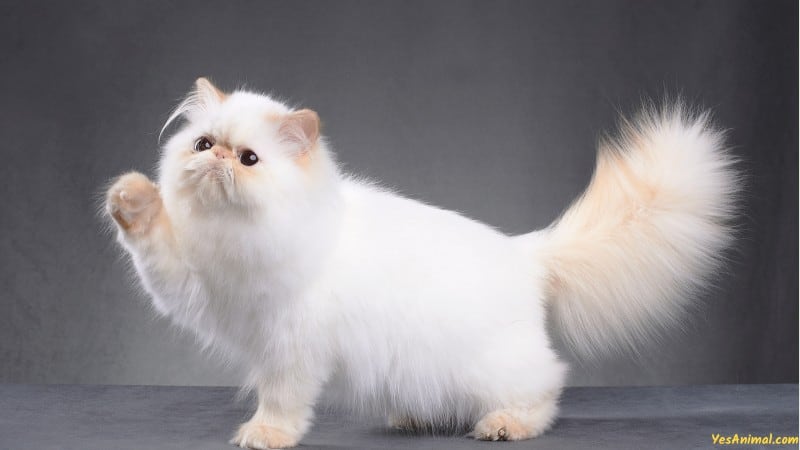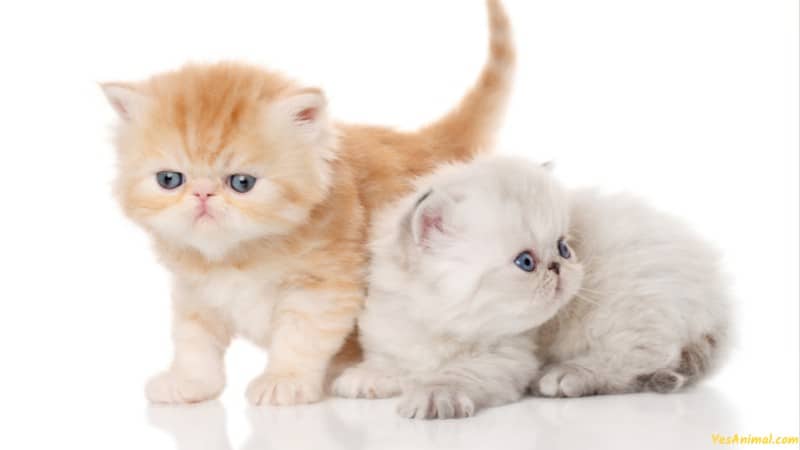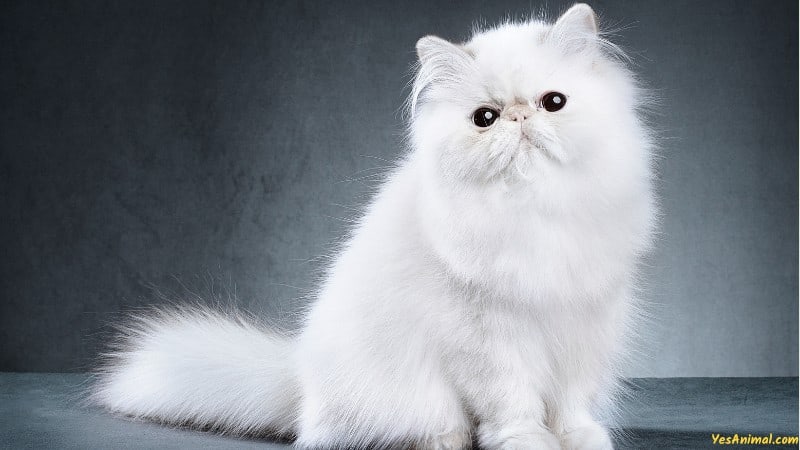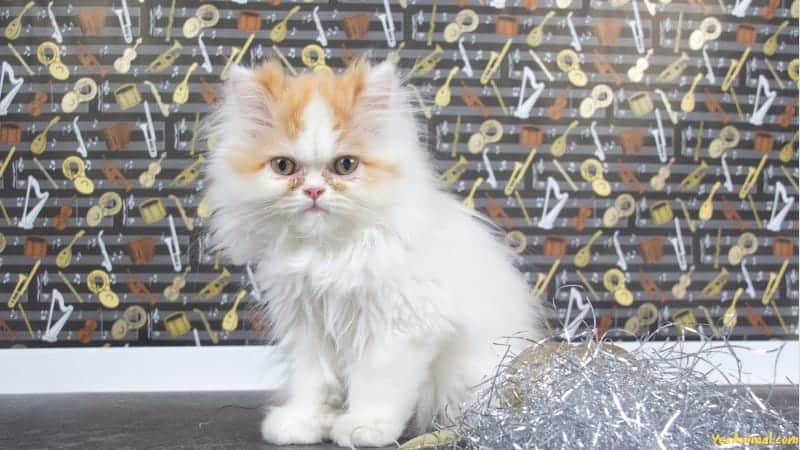Last Updated on July 14, 2024 by Amin Tawar
Persian Kitten Size ( With Persian Kitten Growth Chart)

Popular Persian kittens are greatly valued for their loving personalities and opulent, flowing coats. Persian cats weigh an average of 7 to 12 pounds for females and up to 14 pounds or more for males, placing them on the larger end of the domestic cat size spectrum as a breed.
Persian kittens grow quickly in their first few months, typically weighing between 1-3 pounds at birth. They typically weigh about 75% of their full adult weight by the time they are six months old, and they are fully grown by the time they are a year old.
Here is a Persian kitten growth chart to give you a better idea of the breed’s typical growth and development:
| Persian Cat Age | Average Weight (lbs) | Average Length (inches) |
| Birth to 1 month | 1-3 lbs | 8-10 inches |
| 1-3 Months | 4-7 lbs | 12-16 inches |
| 3-6 months | 7-10 lbs | 16-20 inches |
| 6-12 months | 10-14 lbs | 20-24 inches |
| 12 months + | 10-14 lbs (females)14 lbs and above (males) | 24 inches + |
What Does A Persian Kitten Look Like? All Color Options

The Persian kitten is a breed of cat that is easily recognizable by its distinctive appearance. With a luxurious, flowing coat, sweet facial features, and a gentle demeanor, the Persian is one of the most beloved breeds of cats in the world. But what exactly does a Persian kitten look like?
In terms of body type, the Persian kitten is a medium-to-large breed with a sturdy, compact build. They have short legs, a round face, and a short, flat nose. Their eyes are large and round, and they come in a variety of colors, including green, blue, hazel, and copper.
The most distinctive feature of the Persian, however, is its coat. Persian kittens are born with a dense, fluffy coat that continues to grow and become longer as they mature. The coat is soft and silky to the touch, and it requires regular grooming to keep it looking its best.
When it comes to color, the Persian kitten is one of the most versatile breeds, with a wide range of coat colors and patterns to choose from. Some of the most common coat colors for Persian kittens include:
- Solid: White, Black, Blue, Cream, Red, Silver
- Bi-Color: Black And White, Blue And White, Cream And White, Red And White
- Calico: White, Black, Orange
- Tabby: Silver, Blue, Cream, Red, Brown, Black
- Parti-Color: White And Another Color
- Shaded: Chinchilla, Silver Shaded, Golden Shaded 1
Persian Kitten Behaviour: Are Persian Kittens Friendly Or Aggressive?
When it comes to behavior, the Persian kitten is known for being a sweet and gentle breed.
With their affectionate nature and love of attention, Persian kittens are often referred to as “lap cats.” However, just like any other breed, the personality and behavior of a Persian kitten can vary from individual to individual.
In general, Persian kittens are friendly and playful, and they enjoy spending time with their human companions. They are not typically aggressive, but they can be shy around strangers.
To help your Persian kitten feel more comfortable, it’s important to socialize them from a young age and expose them to a variety of people, animals, and experiences.
Persian Kitten Diet: What Do They Eat?
Have you ever wondered what a Persian kitten should eat in order to grow into a strong and healthy adult cat? As with any other breed, the diet of a Persian kitten is important for its overall health and development.
When feeding a Persian kitten, it’s important to choose high-quality kitten food that provides all of the nutrients that it needs.
Kitten food is specially formulated to meet the nutritional needs of growing cats, and it should be fed in small, frequent meals throughout the day.
In addition to kitten food, Persian kittens may benefit from supplements, such as fish oil or taurine, to support their health. You should consult with a veterinarian to determine the best diet and supplements for your Persian kitten.
Persian Kitten Lifespan & What Is The Survival Rate Of Persian Kittens?

Did you know just how long a Persian kitten can live? The lifespan of a Persian kitten is dependent on several factors, including genetics, diet, and overall health.
On average, the lifespan of a Persian kitten is 12-16 years. With proper care, however, some Persian cats have been known to live well into their late teens and early twenties.
When it comes to survival rate, Persian kittens are generally healthy and have a good chance of growing into strong and healthy adult cats. However, as with any breed, they are susceptible to certain health issues, such as respiratory problems, dental issues, and skin problems.
How Much Does A Persian Kitten Cost?
Have you been dreaming of adding a Persian kitten to your family but are curious about the cost? The cost of a Persian kitten can vary greatly depending on several factors, including the kitten’s age, location, and breeding.
Here’s a table summarizing the average cost of a Persian kitten in different countries:
| Country | Persian Kitten Average Cost |
| United States | $1,000 to $3,000 |
| United Kingdom | £800 to £2,000 |
| Canada | CAD 1,000 to CAD 2,500 |
| India | INR 50,000 to INR 1,50,000 |
| Australia | AUD 1,500 to AUD 3,000 |
Please note that these costs are just rough estimates and that the actual cost of a Persian kitten can vary greatly based on the breeder and location. It’s important to factor in the cost of supplies and any necessary veterinary expenses as well.
Are Persian Kittens Good Pets?
Are you considering adding a Persian kitten to your family and wondering if they make good pets? With their sweet and gentle personalities, gorgeous coats, and affectionate nature, it’s easy to see why Persian kittens are a popular choice for cat lovers.
Persian kittens are known for their affectionate and docile personalities, making them ideal pets for families, couples, and individuals who want a companion that loves to cuddle and be close. They are generally friendly and get along well with children and other pets.
Persian Kitten Compared To Regular Kitten

While both types of kittens are adorable and have their own unique qualities, there are a few key differences between Persian kittens and regular kittens.
One of the main differences is their appearance. Persian kittens have unique, rounded faces and longer, thicker coats than regular kittens. They also come in a wider range of coat colors and patterns, from solid white to black, blue, cream, and beyond.
Another difference is personality. Persian kittens are known for their gentle and affectionate nature, while regular kittens can be more energetic and playful.
This means that Persian kittens may be a better fit for individuals or families who are looking for a companion that loves to cuddle and be close, while regular kittens may be better suited for those who are looking for a more active and playful pet.
In terms of care, Persian kittens require more grooming due to their long coats, while regular kittens typically require less grooming.
This means that owning a Persian kitten may require a bit more time and effort in terms of grooming, but the result is a beautiful and soft coat that can be quite stunning.
Do Persian Kittens Sleep & Shed A Lot?
Lastly, it’s important to consider the sleep and shedding patterns of Persian kittens if you’re considering adding one to your family.
Like all cats, Persian kittens need plenty of rest and sleep, typically 12-16 hours per day. They tend to sleep in cozy and comfortable places, such as a soft bed or a warm sunbeam.
As for shedding, it’s true that Persian kittens have longer and thicker coats than regular kittens, which means they shed more.
However, regular grooming can help to minimize shedding and keep their coats looking healthy and shiny. It’s also important to brush your Persian kitten regularly to help remove loose fur and prevent matting.
Persian Kitten Care Tips
Are you thinking of getting a Persian kitten as a pet, then here are some important Persian kitten care tips to keep in mind:
- Regular grooming: Persian kittens have long, thick fur that requires daily brushing to prevent matting and tangles. You should also bathe your Persian kitten frequently to keep its coat clean and shiny.
- Feed a balanced diet: Provide your Persian kitten with high-quality kitten food and make sure it has access to fresh water at all times.
- Provide a clean and safe environment: Keep your Persian kitten’s litter box clean, provide plenty of toys for playtime, and make sure its sleeping area is comfortable and secure.
- Regular veterinary check-ups: Take your Persian kitten for regular veterinary check-ups to keep it healthy and address any potential health issues early on.
- Socialization: Socialize your Persian kitten from a young age to help it feel comfortable around people, other animals, and new experiences.
- Playtime: Persian kittens are energetic and playful, so make sure to provide plenty of opportunities for playtime to help keep them happy and healthy.
- Limit exposure to outdoor dangers: As an indoor breed, it’s important to keep your Persian kitten safe from outdoor dangers, such as cars, other animals, and toxic plants.
By following these Persian kitten care tips, you can help ensure that your furry companion grows into a healthy and happy adult cat.
Conclusion
And that was everything you need to know about the Persian Kitten. I hope this article was informative enough and your queries were answered.
Thank You For Reading!
Related Articles You May Like